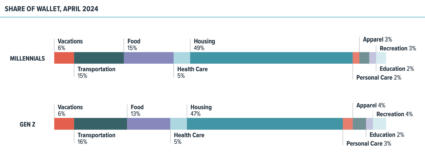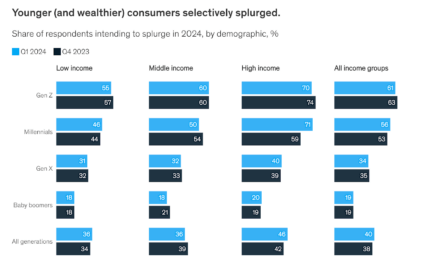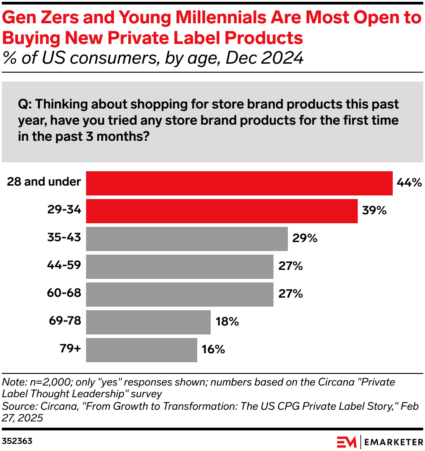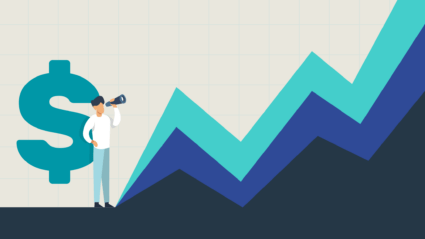While it’s not yet clear exactly how President Trump’s proposed new tariffs will be implemented, many marketers are bracing for a major impact on US shoppers.
Budget-conscious consumers have already been hit hard by inflation, and new price increases are likely to cut their spending further. Younger consumers, who are earlier in their careers and have less financial stability, are likely to be even more impacted by these changes.
And brands can’t afford to ignore Gen Z—they’re the future. Gen Z makes up about a fifth of the US population, and their global spending power is projected to rise from $2.7 trillion in 2024 to almost $12.6 trillion by 2030, according to eMarketer.
Gen Z’s increasing importance to retailers makes it a crucial audience for brands to target as tariffs come into effect, especially since this generation is more sensitive to price than older cohorts.
How Gen Z spends differently vs. older generations
It’s still early days for Gen Z when it comes to their adult careers and personal milestones like marriage. Currently, the generation ranges from ages 13 to 28, putting them in a transitional phase that presents unique challenges, even apart from tumultuous times like these.
After facing events like the pandemic and inflation in the early years of their adulthood, even the oldest Gen Zers may not be fully settled into their grown-up lives. Many still depend on their parents for help: more than 60% of Gen Z consumers said they were relying on their parents for at least some financial support in 2023.
But that doesn’t mean this cohort hasn’t been spending. Instead, cohabitating with parents or friends rather than on their own or with dependents gives them the flexibility to reallocate some of their spending from necessities (such as housing and food) to discretionary purchases like experiences, apparel, and personal care.
-

Source: Morning Consult
This generation loves to splurge, even when it isn’t necessarily within their means. More than half of Gen Z is planning to splurge, according to McKinsey, which is far higher than older generations like Gen X (31%) and baby boomers (20%).
Part of the reason for younger generations’ willingness to spend is what the internet calls “little treat” culture: making small emotional purchases to feel better. Gen Z’s overall pessimism about the future (especially with the new threat of tariffs) has led them to cope with fears about the economic and political climate through retail therapy.
-

Source: McKinsey
That negative outlook also means many young people don’t feel motivated to save money for financial goals. After all, what’s the point of a 401(k) when the future looks bleak?
Many Gen Zers are opting to spend that money today rather than saving it for a future “that feels like it could change at any moment,” according to an Axios Vibes survey.
Of course, reckless spending still has consequences, and all those “little” treats can add up over time. The Axios survey also found that around 40% of millennials and Gen Zers who say they are financially squeezed blame their money problems on their own “excessive spending on non-essentials.”
Tariff impacts on Gen Z spending
Despite their general pro-spend behavior, Gen Z is still feeling the financial pinch. In fact, today’s circumstances may have a more extreme impact on Gen Z than on older consumers since they’re still in the middle of building their adult lives.
Tariffs, unfortunately, come at a time when Gen Z has already tightened its collective belt: In 2024, 73% of Gen Z already said they made changes to their spending in response to increased prices, according to a Bank of America poll.
Now, the Trump administration’s moves to restart student loan repayments after several years of leniency and forbearance will take another huge bite out of Gen Z’s purchasing power. Consider this: it will be the first time consumers who graduated in the pandemic will feel the full budgetary squeeze of student loan repayment. And as unemployment rates rise, these same exact shoppers are becoming increasingly concerned about their job prospects, stability, and upward mobility.
Given what we know about this audience in general, as well as the data rolling in so far, here are three trends that will define Gen Z shopping in the coming months:
- Buying secondhand: Tariffs will likely amplify the resale trend that’s already popular with young consumers. 68% of Gen Z and millennials already buy secondhand, according to ThredUp’s 2025 Resale Report, and as tariffs increase prices for apparel, footwear, and other products, we’ll likely see more Gen Z customers turning to the secondhand market. Brands may be able to take advantage of this by starting resale programs (76% of brands without one say they’re considering a program).
- Shopping for value: Young consumers will continue to shop at discount retailers like T.J. Maxx, Nordstrom Rack, and Marshalls. Gen Z and millennials are also increasingly joining warehouse clubs; they now account for about half of Sam’s Club’s new memberships.
- Trading down: Regardless of the retailer, younger shoppers are also willing to swap products they currently use for cheaper or private label options.
-

Source: eMarketer
How can brands reach Gen Z amidst tariffs and uncertainty?
Remember that even as consumers cut down on spending, they’re still human: They’ll continue to look for small discretionary treats and fun purchases to help them get through these tough times.
To reach Gen Z as the economy continues to shift, it becomes increasingly important to speak directly to their needs and show up when and where they shop. To preserve—and maybe even grow—your revenue coming from this sizable and strategically important segment, refocus your marketing plan around these four timely plays:
- Prioritize value-focused messaging: Gen Zers love deals and discounts, so advertising around your product or service’s value in comparison to other items or offerings is a great way to get their attention. Budget-minded shoppers also appreciate sales events—so get planning!
- Explore retail media networks: Gen Z shoppers are drawn to low-cost retailers and make many of their purchases online. If you haven’t already, start exploring the retail media networks associated with Gen Z’s favorite brands so your products are right in front of them when and where they buy.
- Become their “little treat:” Since Gen Z shoppers are still going to splurge (at least sometimes), tap into impulse spending happening on social platforms like TikTok, Instagram, and Snapchat.
- Be open and honest: You can’t control tariffs, but you can control how you communicate around them. If you need to make price changes, update your customers in a clear and timely fashion so they know just what to expect. In terms of the “why”, depending on your company’s policies with respect to politics, you may or may not want to explain the reasoning behind your pricing.
Regardless of your brand’s marketing plan, you should invest in understanding how rising costs and economic volatility are impacting younger audiences. Gen Z shoppers aren’t just the future anymore–they’re a major consumer cohort that brands need to reach and win over starting right now.







Responses